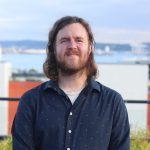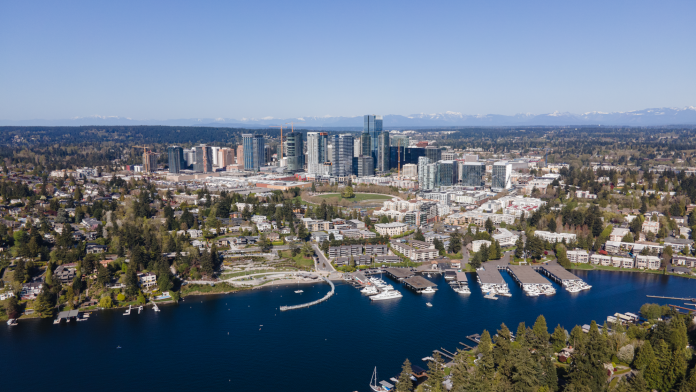
The Eastside has major light rail openings and initiatives queued up next year, snatching the spotlight from Seattle.
If you’re looking for a city government with a positive urbanist vision with momentum behind it, you might be looking outside Seattle. While there are bright spots in nearly every corner of Puget Sound — in cities large and small — it’s on the Eastside where big changes are on the way and momentum is building — a fact that is leading The Urbanist to declare 2025 the Year of the Eastside.
Neighborhoods east of Lake Washington may start from a place of car-centric suburban development, but a cadre of Eastside cities are finding their footing on the road to becoming more welcoming, walkable places. Using Sound Transit light rail as a major impetus, Bellevue and Redmond have been leading the pack in transit-oriented development — both with their own strengths and weaknesses.
Cities like Kirkland, Bothell, Sammamish, and Issaquah are also all moving forward on initiatives that entail making more room for new neighbors, which vary in scale and ambition. Since Seattle city leaders appear mostly focused on reactionary initiatives and incremental tweaks over big ideas, the pendulum may be swinging to the Eastside to lead the region.
East Link light rail expansions set the stage for boosting housing, transforming streetscapes, and breaking free of car dependence. Sound Transit’s bus rapid transit openings tabbed for 2028 and 2029 will offer a chance to build on that momentum. The next few years will be pivotal for Eastside cities to seize on the opportunities presented and execute an urban transformation. Stumbling, meanwhile, would mean falling into old patterns of being an exclusive suburban enclave built around cars — ceding regional leadership back to the other side of the lake.
Seattle still posted big homebuilding numbers in 2024, with 4,200 homes under construction in the Downtown core alone, according to the Downtown Seattle Association, led by a 45-story tower that broke ground in August. However, permit applications are dwindling, and the City seems to lack a clear vision to guide the urban transformation it wants over the next decade.
The One Seattle Comprehensive Plan is late in coming together, with little fanfare from the Harrell Administration to roll it out or make the case for new neighborhood centers, anemic as they are, which are drawing some pushback from the usual suspects. Likewise, Mayor Bruce Harrell oversaw the passage of a transportation levy that was significantly bigger in size, but significantly smaller in vision, with far smaller targets for bike and transit infrastructure.
The 2 Line finally arrives in full form
Both of the two major regional transit openings scheduled for this year will be happening on the Eastside. This spring, Sound Transit’s 2 Line will be extended from Redmond Technology Station to Downtown Redmond, with a stop in Marymoor Village near King County’s largest park. The first Sound Transit 3 rail project to start carrying passengers, the Downtown Redmond Link Extension finally brings service to Redmond’s largest growth center, a downtown that has seen rapid transformation over the past decade.
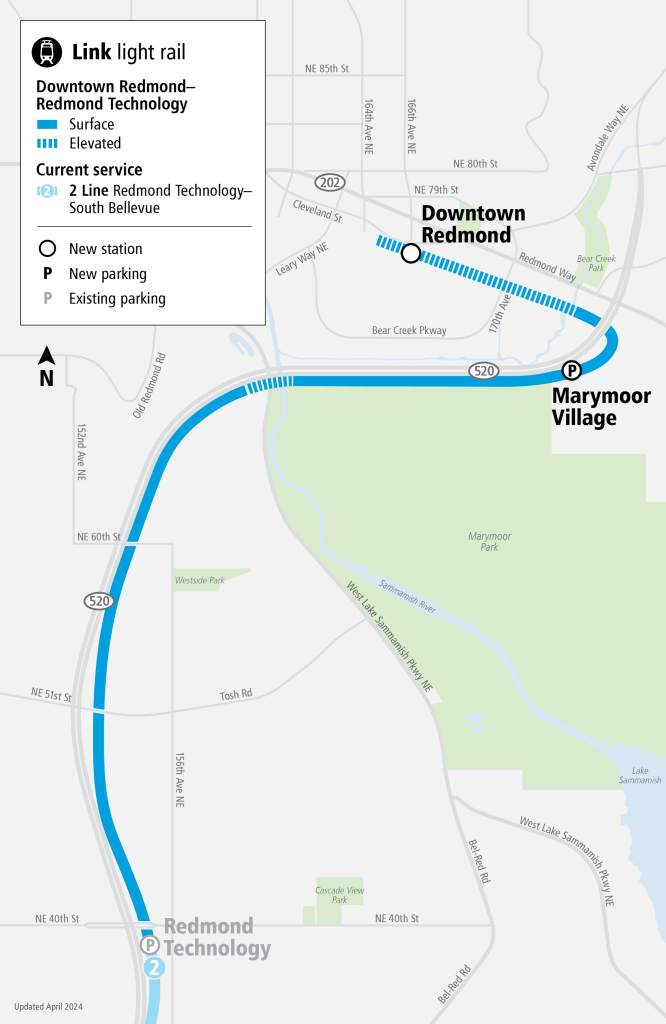
Then by the end of the year, the 2 Line will finally start to run past South Bellevue Station across Lake Washington, stopping at new stations in Mercer Island and Seattle’s Judkins Park neighborhood before connecting with International District/Chinatown Station downtown and then heading north to Lynnwood. The long-delayed start of service, the first light rail line in the U.S. set to cross a floating bridge as part of its alignment, has been highly anticipated and is going to make the Eastside more accessible than ever, along with providing extra frequency on the overcrowded segments of the 1 Line north of Downtown Seattle.
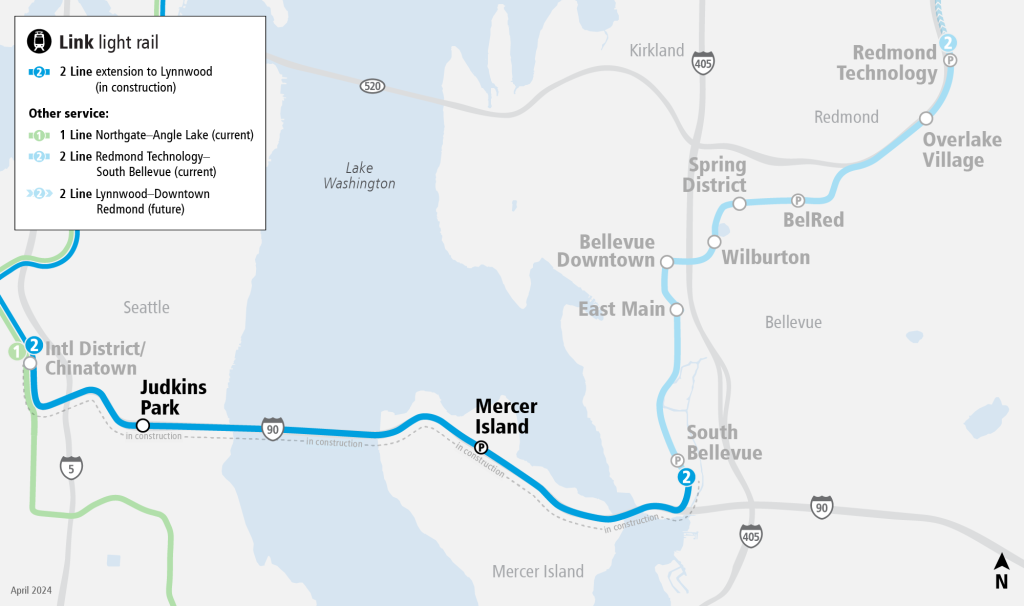
Will the full 2 Line actually arrive on time in 2025? Sound Transit says it has “all hands on deck” to make it happen.
“[O]ur target is for trains to be on the floating bridge in Q1 2025, and to start pre-revenue service (which includes training for operators and maintenance staff, and continued testing to ensure stations, tracks, utilities, and vehicles work together as expected) in Q2, leading to a late 2025 opening,” an agency update from mid-December noted.
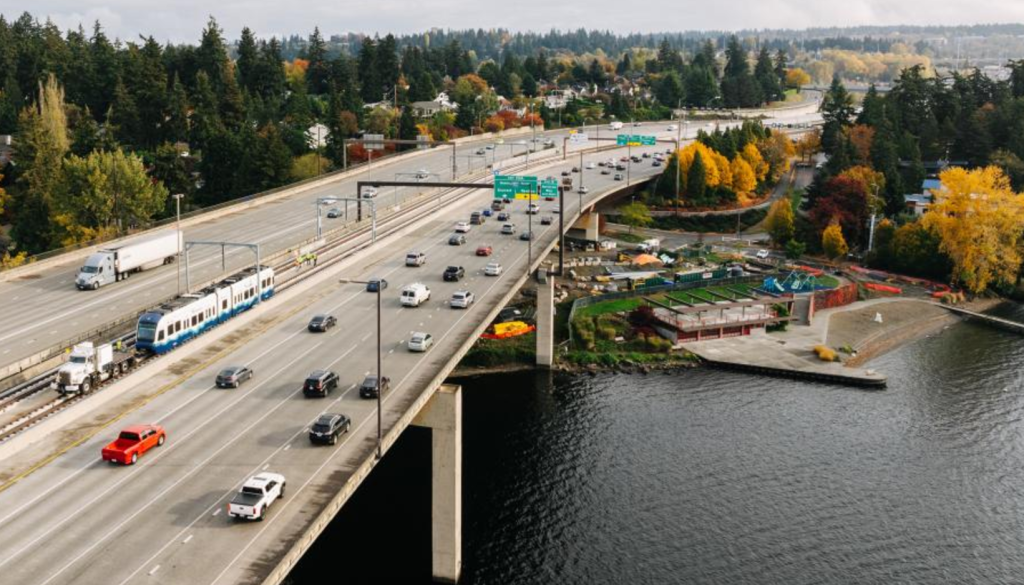
On top of the 2 Line launch will be supplemental transit connections, thanks to the East Link Connections bus restructure. As routes are rerouted to better take advantage of the light rail line, King County Metro will be able to add more frequent service through additional cities, like Kirkland, Issaquah, Woodinville and North Bend.
Sound Transit’s light rail network already experienced record-setting growth in ridership in 2024 with the launch of Lynnwood Link, and 2025’s openings are poised to blow that out of the water.
Bellevue primes Wilburton, Redmond continues to densify
In 2025, we’ll be intensely following the work that Eastside cities are doing to densify and urbanize — work sure to come in fits and starts. Beachheads of transit-rich urbanism planted in Eastside suburbia has the potential to transform the entire region.
Bellevue, on the heels of adopting the fairly ambitious growth framework in its Comprehensive Plan, is set to get to work on figuring out how to prime the Wilburton neighborhood for development. Close to both light rail and the burgeoning Eastrail regional trail network, Wilburton has considerable potential, but its transition away from an area of surface parking lots and car dealerships will be anything but easy.
After setting the stage for development there, Bellevue will be moving on to BelRed, another area of high potential, but the city’s overall inclination to try and bring its car-centric tendencies along with it on the path to being a big city will almost certainly prove problematic. And of course, development continues to hum along in Downtown Bellevue, with even more residential focus in recent plans and revisions. Unfortunately, plans to forge a bike network in Bellevue’s core have stalled out, for now, in part due to resistance from real estate mogul Kemper Freeman, Jr.
Redmond aggressively added housing in Overlake and Downtown ahead of its East Link station openings. The Redmond City Council aims to keep that momentum up with its Redmond 2044 Comprehensive Plan that further upzones those core light rail neighborhoods, along with Marymoor Village. However, homebuilders have warned that increased affordable housing requirements and environmental standards could end up stunting growth going forward — and jeopardizes projects in the development pipeline.
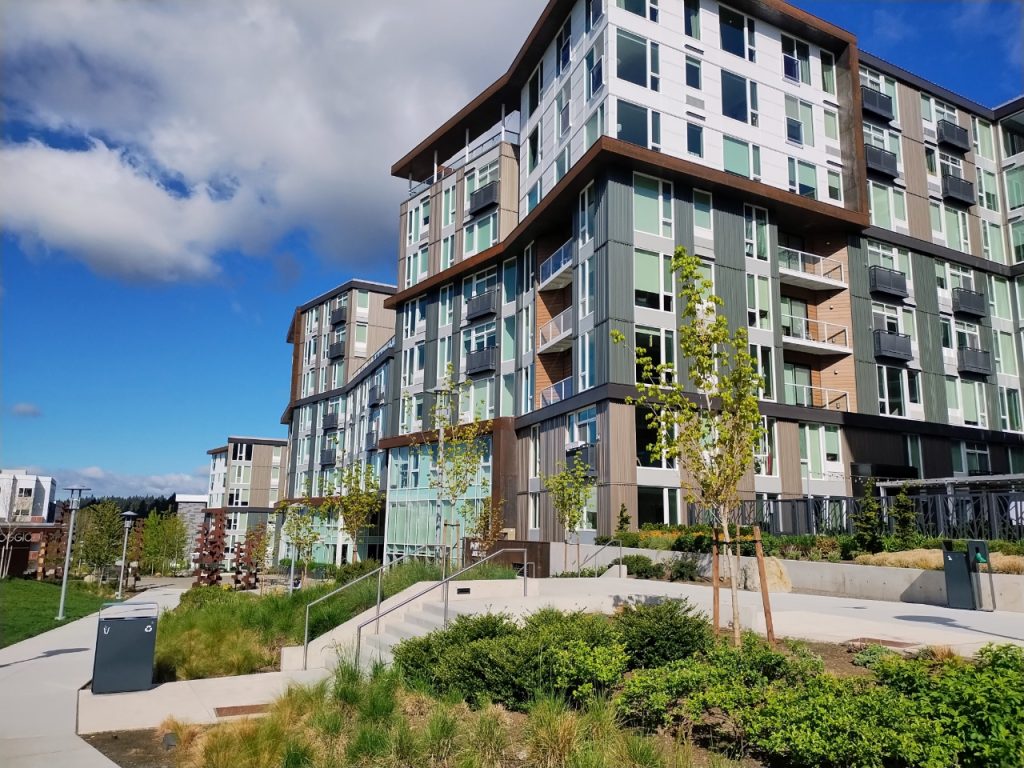
The Kirkland City Council is set to consider how to move forward with creating a community hub near the Houghton neighborhood. While rezone proposals did kick up neighborhood housing opposition, Kirkland councilmembers do appear intent on working through it and ultimately pursuing a 10-minute city vision.
The Bothell City Council is poised to decide the long-term future for its popular pedestrianized Main Street, while also moving forward with utilizing city-owned land nearby for affordable housing. The urbanist faction won a majority of seats on Bothell’s council in the 2023 election, giving Mayor Mason Thompson allies to advance pro-housing reforms and safe streets projects.
In Sammamish, that city’s longstanding Town Center plan is set to bear fruit.
In contrast with those standout cities, we’ll be keeping an eye on places like Woodinville, which is heading toward adopting a growth framework that King County’s Affordable Housing Committee has called out as particularly problematic. Meanwhile tiny Eastside jurisdictions like Medina, Clyde Hill, Hunts Point, Yarrow Point and Beaux Arts Village grapple with complying with state housing law while attempting to change their overall land use frameworks as little as possible. Ditto Mercer Island.
A champion for the Eastside seeks to lead King County Government
The work happening to increase housing supply, improve transportation, and create more vibrant communities on the Eastside is set to get a countywide stage next year, as the open primary to become the next King County Executive heats up. Executive Dow Constantine announced he’s stepping aside after his fourth term concludes.
King County Councilmember Claudia Balducci is vying to become the first Eastsider elected to lead the county, and is pointing to her long track record of collaborating with other leaders in the area to get things done. She served on the Bellevue City Council from 2004 to 2015 and as Mayor from 2014 to 2015, when she won election to the King County Council. Balducci has chaired Sound Transit’s Systems Expansions Committee since 2019. Check out our interview with Balducci for more.
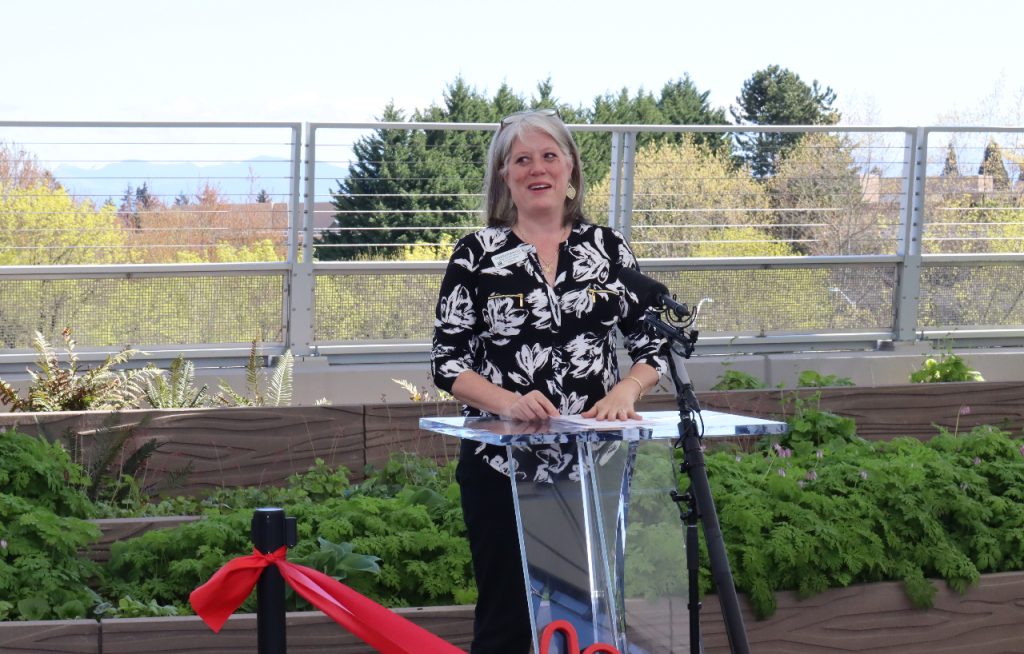
Balducci played a pivotal role in delivering the forthcoming 2 Line through Bellevue, though an alignment decision that was heavily contentious. With that project coming online, she’s been focused on improving connections to the Eastside via decisions that are getting made now around other major ST3 projects, including Ballard Link.
A through-line in Balducci’s career in elected office has been a push to increase shelter and supportive housing options in East King County, with the 100-bed Porchlight men’s shelter finally opening in 2023 after years of stewardship. She’s been a steadfast defender of the “Housing First” approach to alleviating homelessness and the need to expand services throughout the region, even as individual projects within her district have faced significant backlash.
Competing visions set to clash in other Eastside elections
Apart from the high-profile county executive’s race, 2025 will see city council elections across the Eastside that could have a big impact on the region. At the top of the list is Bellevue, where Mayor Lynne Robinson is expected to run for a fourth term but could face challenges from both her right and her left.
Robinson’s tenure has been known for a “bring everyone along” style, an approach that has not fared well for bold initiatives like Bike Bellevue. With a “weak Mayor” system in place in Bellevue, Robinson has been selected to lead the city council twice before, and a successful challenge against her could change the entire dynamic of the council.
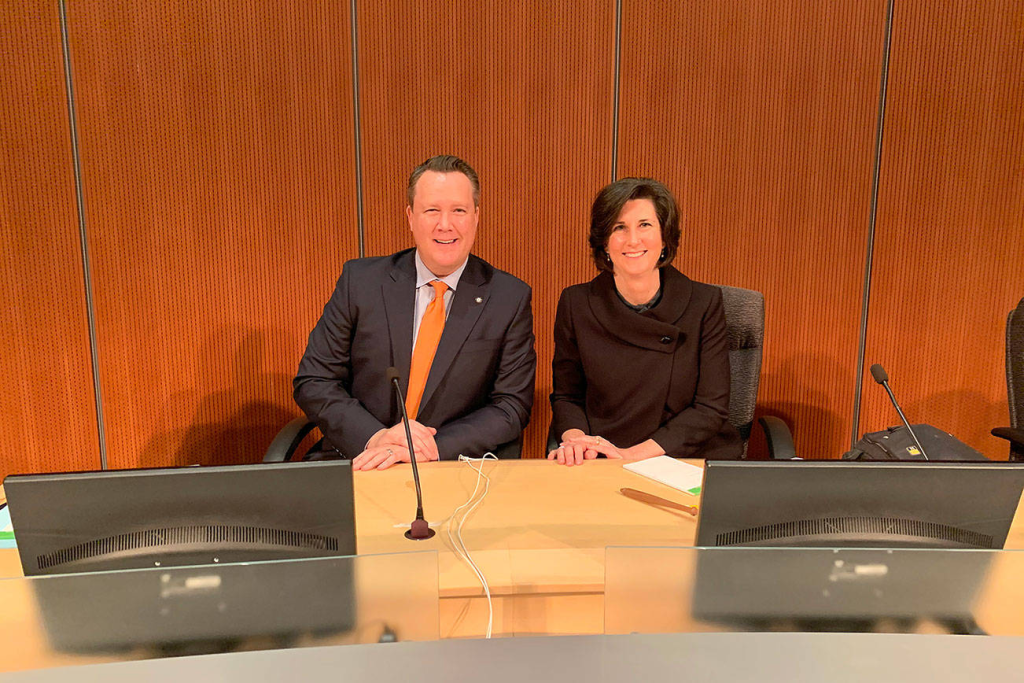
Also up for reelection is Robinson’s more conservative colleague Jared Nieuwenhuis, who has already raised a significant warchest via donations from longtime Bellevue power players like real estate tycoon Kevin Wallace. And then there’s Conrad Lee, who has served on the Bellevue City Council since 1994 and could face a challenge this year, if he decides to seek another term.
Further east in Issaquah, the Mayor’s race is already shaping up to be a generational contest. With incumbent Mayor Mary Lou Pauly not seeking a third term, both current Council President Lindsey Walsh and outgoing State Senator (and former Issaquah Councilmember) Mark Mullet have thrown their hats in the ring to lead the city of 41,000 residents. Mullet has boasted of his investments in affordable housing on the state level, but as a member of Issaquah’s old guard his vision is set to clash with Walsh’s, which is more overtly pro-density. Earlier this year, Walsh led the charge on reducing onerous restrictions on housing in Issaquah’s Center City neighborhood in order to spur more homebuilding, a debate which isn’t likely to be going away any time soon.
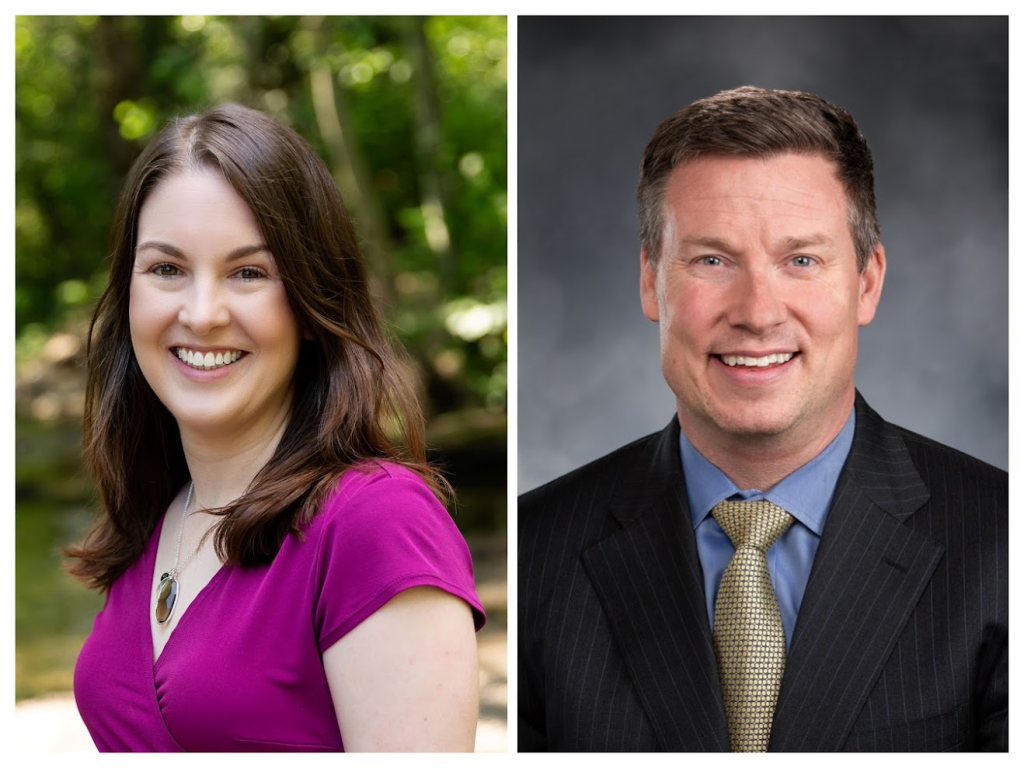
Other races we’re watching in 2025 include likely reelection campaigns for progressives Melissa Stuart in Redmond, Jay Arnold in Kirkland, and Jenne Alderks and Rami Al-Kabra in Bothell. Vacancies opening up in the state legislature in both the 48th Legislative District and the 41st Legislative District are also poised to change the dynamics of multiple Eastside city councils, but the dust won’t settle on those appointments for another few weeks.
While momentum is building on the Eastside, it’s tenuous, and cities are sure to face backlash and backsliding. Local urbanist leaders will have their work cut out for them, and reinforcements would certainly help.

